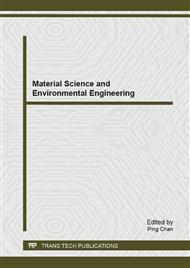p.214
p.218
p.224
p.231
p.237
p.244
p.248
p.256
p.260
Influence of Ultrasonic Time on the Preparation and Properties of LaCoO3 Nanoparticles
Abstract:
Ultrasonic assisted citrate sol-gel is used to synthesis LaCoO3 (LCO) ultrafine particles. The influence of ultrasonic time on the properties of the samples was investigated. TG-DSC is applied to determine the phase transition of LCO gel precursor. XRD, FESEM and H2-TPR were applied to characteristic crystalline phase structure, morphology, thermal stability of LCO samples. The results indicated that LCO particles exhibit a well-formed polycrystalline rhombohedral distorted perovskite structure, and their particles are well-decentralized, in a smaller size and better dispersivity as the increasing of ultrasonic time ranged from 0min to 60min. H2-TPR implied that ultrasonic assistance can lower the reduction temperature of the product in the zone of low temperature and raise the temperature in the zone of high temperature. Ultrasonic assistance is not conductive to increase organic dye decolorization efficiency of LCO powders in darkroom when taking methyl orange and gold orange II as targeted dye.
Info:
Periodical:
Pages:
237-243
Citation:
Online since:
May 2014
Authors:
Price:
Сopyright:
© 2014 Trans Tech Publications Ltd. All Rights Reserved
Share:
Citation:


